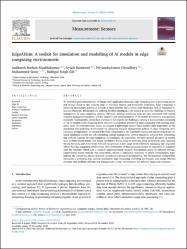| dc.contributor.author | Nandhakumar, Aadharsh Roshan | |
| dc.contributor.author | Baranwal, Ayush | |
| dc.contributor.author | Choudhary, Priyanshukumar | |
| dc.contributor.author | Golec, Muhammed | |
| dc.contributor.author | Gill, Sukhpal Singh | |
| dc.date.accessioned | 2024-02-28T07:31:57Z | |
| dc.date.available | 2024-02-28T07:31:57Z | |
| dc.date.issued | 2024 | en_US |
| dc.identifier.issn | 26659174 | |
| dc.identifier.uri | https://doi.org/10.1016/j.measen.2023.100939 | |
| dc.identifier.uri | https://hdl.handle.net/20.500.12573/1972 | |
| dc.description.abstract | To meet next-generation Internet of Things (IoT) application demands, edge computing moves processing power
and storage closer to the network edge to minimize latency and bandwidth utilization. Edge computing is
becoming increasingly popular as a result of these benefits, but it comes with challenges such as managing resources efficiently. Researchers are utilising Artificial Intelligence (AI) models to solve the challenge of resource
management in edge computing systems. However, existing simulation tools are only concerned with typical
resource management policies, not the adoption and implementation of AI models for resource management,
especially. Consequently, researchers continue to face significant challenges, making it hard and time-consuming
to use AI models when designing novel resource management policies for edge computing with existing simulation tools. To overcome these issues, we propose a lightweight Python-based toolkit called EdgeAISim for the
simulation and modelling of AI models for designing resource management policies in edge computing environments. In EdgeAISim, we extended the basic components of the EdgeSimPy framework and developed new AIbased simulation models for task scheduling, energy management, service migration, network flow scheduling,
and mobility support for edge computing environments. In EdgeAISim, we have utilized advanced AI models
such as Multi-Armed Bandit with Upper Confidence Bound, Deep Q-Networks, Deep Q-Networks with Graphical
Neural Network, and Actor-Critic Network to optimize power usage while efficiently managing task migration
within the edge computing environment. The performance of these proposed models of EdgeAISim is compared
with the baseline, which uses a worst-fit algorithm-based resource management policy in different settings.
Experimental results indicate that EdgeAISim exhibits a substantial reduction in power consumption, highlighting the compelling success of power optimization strategies in EdgeAISim. The development of EdgeAISim
represents a promising step towards sustainable edge computing, providing eco-friendly and energy-efficient
solutions that facilitate efficient task management in edge environments for different large-scale scenarios. | en_US |
| dc.language.iso | eng | en_US |
| dc.publisher | ELSEVIER | en_US |
| dc.relation.isversionof | 10.1016/j.measen.2023.100939 | en_US |
| dc.rights | info:eu-repo/semantics/openAccess | en_US |
| dc.subject | Edge AI | en_US |
| dc.subject | Edge computing | en_US |
| dc.subject | Artificial intelligence | en_US |
| dc.subject | Toolkit | en_US |
| dc.subject | Machine learning | en_US |
| dc.subject | Cloud computing | en_US |
| dc.subject | Simulation | en_US |
| dc.subject | Modelling | en_US |
| dc.subject | EdgeAISim | en_US |
| dc.subject | Python | en_US |
| dc.title | EdgeAISim: A toolkit for simulation and modelling of AI models in edge computing environments | en_US |
| dc.type | article | en_US |
| dc.contributor.department | AGÜ, Mühendislik Fakültesi, Elektrik - Elektronik Mühendisliği Bölümü | en_US |
| dc.contributor.authorID | 0000-0003-0146-9735 | en_US |
| dc.contributor.institutionauthor | Golec, Muhammed | |
| dc.identifier.volume | 31 | en_US |
| dc.identifier.startpage | 1 | en_US |
| dc.identifier.endpage | 14 | en_US |
| dc.relation.journal | Measurement: Sensors | en_US |
| dc.relation.publicationcategory | Makale - Uluslararası Hakemli Dergi - Kurum Öğretim Elemanı | en_US |


















